De Tinieblas
Creation
Stefano Gervasoni
Outline
- Version Information
- Detailed Staff
- Channel Details
- Electronic Equipment List
- Work Related Information
- Downloads
- Instructions
- 1. Audio setup
- Audio Outputs
- 2. Loudspeaker setup
- 3. Midi setup
- 4. Software installation
- 4. Softwares configuration
- b) Live patch configuration
- c) If video is played
- 5. Live patch presentation
- Main patch
- 6. Initialization routine
- Main patch
- 7. System calibration and tests
- 8. Performance notes
- Bet
- Guimel
- Dalet
- He
- Vav
- Zayin
- Het
- Tet
- Yod
- Caf
- Lamed
- Mem
- Nun
action
Updated at
Vous constatez une erreur ?
The setup and the execution of the electroacoustic part of this work requires a Computer Music Designer (Max expert).
Version Information
- Performance date
- 11 juin 2022
- Documentation date
- 28 septembre 2023
- Version
- Creation
- Status
- valid
- Validation date
- 25 octobre 2023
- Documentalist
- Benoit Meudic (Benoit.Meudic@ircam.fr)
- Realisation
- Benoit Meudic (Computer Music Designer)
- Sylvain Cadars (Sound engineer)
- Stefano Gervasoni (Composer)
- Length
- 55 min
No other versions
Detailed Staff
2 sopranos, 2 contraltos, 2 tenors, 2 bass voices
Detailed staff comes from Brahms, send mail to ressources-contenus@ircam.fr for correction.
Channel Details
- Number of input channels
- 16
- Number of output channels
- 9
Electronic Equipment List
Computer Music Equipment
- 1 BCF 2000
- MIDI Mixer (Behringer) - for mixing electronics
- 1 MacBook Pro
- Apple Laptops (Apple) - Main computer (with at least mac os 10.15.7)
- 1 Live
- Music Software (Ableton) - Live 10 (not compatible with Live version 11 !!!)
- 1 Digiface Dante
- Sound Board (RME)
Downloads
Score
28.21 Mo
electronic treatments
718 Octets
video low resolution
238.24 Mo
technical rider
Sylvain Cadars
1.78 Mo
Ableton Live Patch concert
Benoit Meudic
4.07 Go
Old working materials
16.39 Go
Instructions
1. Audio setup
The piece is for 32 singers, electronics and video (an alternative version could be for 24 singers): 8 soprani (S1..8), 8 alti (C1..8), 8 tenore (T1..8) and 8 bass (B1..8).
The score is divided into 14 parts, each part corresponding to one letter of the hebrew alphabet (aleph, bet, guimel, dalet, he, vav, zayin, jhet, tet, yod, caf, lamed, mem, nun).
The electronics consists in realtime treatments, soundfiles, video files and a click for the conductor (for some parts).
The events are trigerred sometimes by hand sometimes by a click-track.
The video files (optional) are played on a specific computer. The video sequences are triggerred by osc messages sent from the main patch and played locally with the application ‘mix16pro’.
The singers are divided into two choirs (stereo Tut1 and stereo Tut2).
Some singers are soloists and have wireless microphones.
Groups of soloists are mixed mono at the console in soloists Left (solG) and soloists Right (solD).
Some singers share a fixed microphone.
Note: depending on the venue and the number of singers, the repartition of microphones can change. If so, that should be discussed with the composer...
Audio Inputs
- 1: S5
- 2: B8
- 3: solG
- 4: solD
- 5-6: Tut1
- 7-8: stereo mix of T1 T2 T3 T4
- 9-10: stereo mix of C1 C2 C3 C4
- 11-12: stereo mix of S1 S2 S3 S4
- 13-14;: stereo mix of B1 B2 B3 B4
- 15-16: Tut2

Audio Outputs
Diffusion is performed in an 8-point system plus 1 output for click-track (see layout below).
The Live section sends outputs in ascending order (1 to 8). The sound engineer routes the corresponding outputs in his console. Output 16 is for click-track.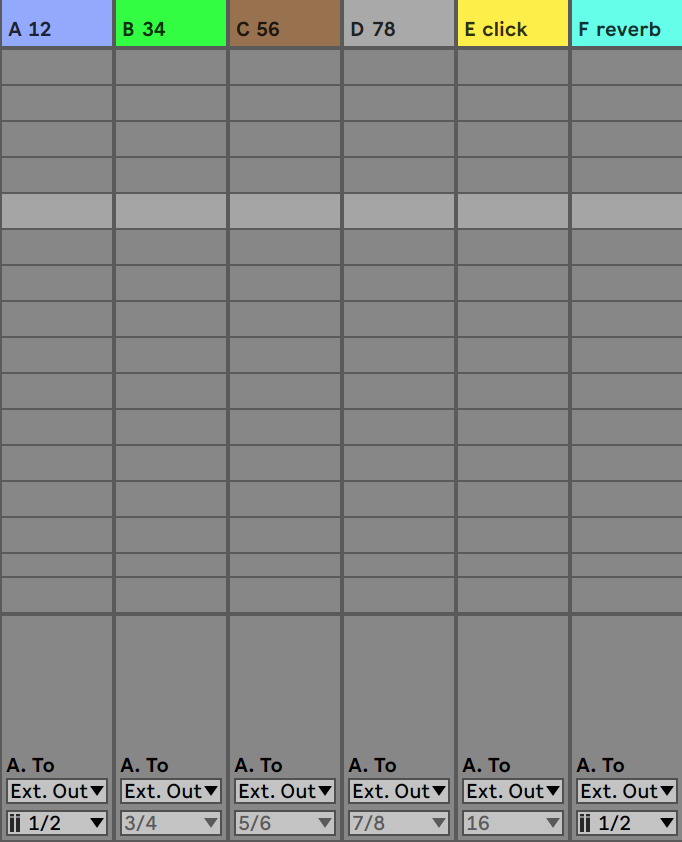
2. Loudspeaker setup
An 8-point synth is required (plus two subs), as well as click for conductor and returns.
Download and check out the technical rider with all the details.
3. Midi setup
A midi controller is required for mixing control (such as a bcf2000). See figure below for midi channel assignments.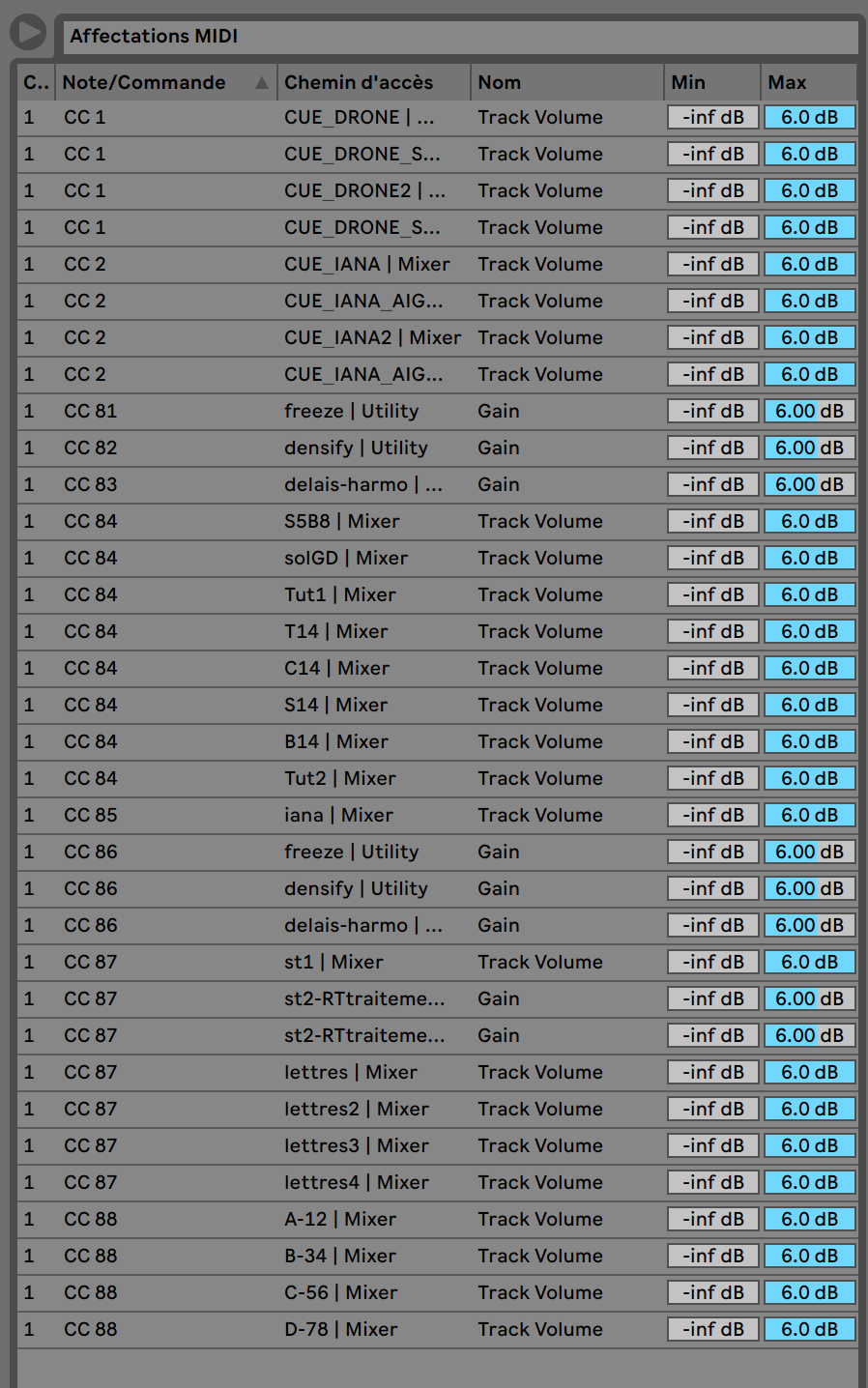
An external midi controler can also be used to trigger the scenes.
If the piece is played with a spare system, a midi interface (such as the Iconnectivity Iconnect MIDI4+) is recommended to synchronise both computers.
4. Software installation
Download all Live session content. This session requires at least Ableton Live 10 Suite 10.1.25.
Max 8 software is also required to edit Max4live devices.
4. Softwares configuration
a) Max patch configuration
Make sure you have the correct version of Max 8 in Live’s preferences.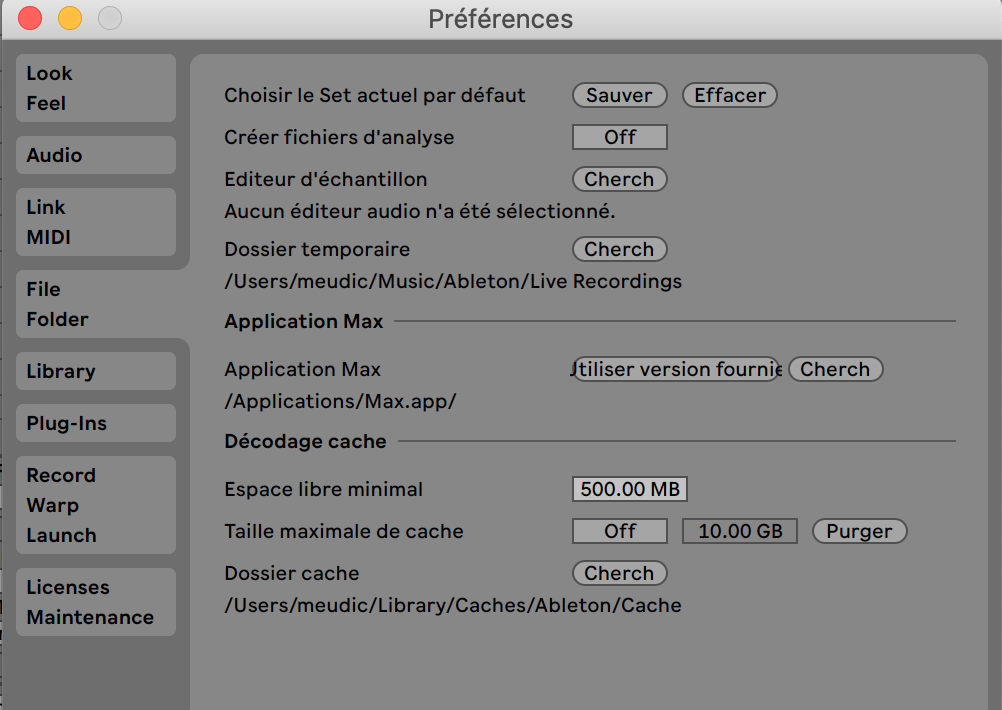
Then open the Max software, go to the options&tab and open File Preferences…
Add the /max folder (and and only this folder) to the path. Close Max and return to Live.
b) Live patch configuration
Open the patch ‘De_Tinieblas-concert17.als’ in Live.
Select your audio device in Live preferences.
DSP audiorate is 48kHz and memory size 128 samples.
If an external device is used for trigerring: select the correct midi input for the track ‘trigger’.
c) If video is played
Note: The video computer should be at least MacBook Pro 16 october 2020 with 8 core/64 Go Ram/8 Go VRAM, with external hard disk 2To SSD 1050 Mo/se
Install ‘Mix16pro’ on the video computer
Activate options/disable system message
Check single playback mode
Manually configure the ip adresses of the computers and specify them in Live (track video) and in Mix16pro.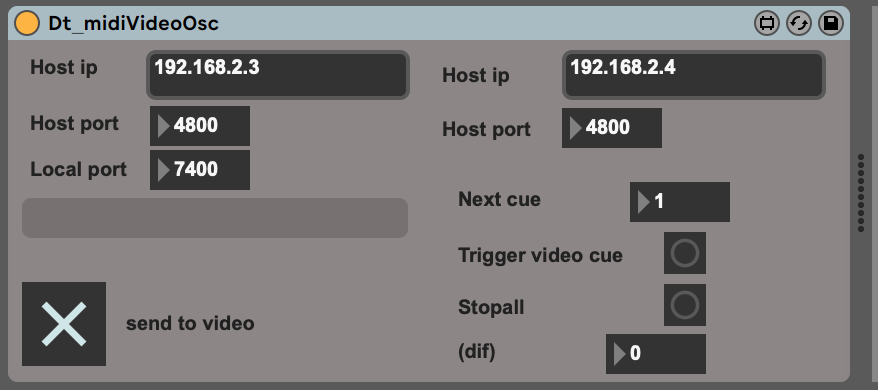
5. Live patch presentation
Shortcuts
Press twice ‘$’ to reset the live session.
Use up and down arrows can be used to select the following scene.
‘enter’ key can be used to trigger the selected scene (master track should be selected).
Main patch
The main patch consists in an Ableton live session ‘De_Tinieblas-concert17’.
From left to right:
- folder ‘inputs’: audio inputs 1-16 from adc 1-16
The inputs are pre-routed to four mono tracks in1 in2 in3 and in4 via the matrix ‘matrixin’.
- ‘matrixin’: The routing is scripted by the name of the clips in the ‘matrixin’ track: a number provided as a name is interpreted as a preset number of the pattrstorage of the matrix.

- ‘iana’: In4 is always routed to this track. The track is a Iana synthesis device followed by a reverb device. The name of the clips of the track can either power a ‘rack number_preset number’ or a ramp for a parameter

The syntax is:
‘rack i_preset j’: turn on rack i of the track and recall preset j. A 0 value means turn off all the racks.
‘p_param_value1_time1_value2_time2_value3_time3’: put parameter param to value1 in time1 ms, then put to value2 in time2 ms then put to value3 in time3 ms.
- folder ‘rtime’: there are 5 tracks, 3 for realtime treatments and 2 for spatialization. Each of these tracks have several possible effects device. The name of the clips of the tracks can either power a ‘rack number_preset number’ or a ramp for a parameter.

The syntax is:
‘rack i_preset j_ramp k’: turn on rack i of the track and recall preset j then put the gain to 0 dB in k ms. A 0 value means turn off all the racks (by default after setting the gain to -127 in 1000 ms).
‘p_param_value1_time1_value2_time2_value3_time3’: put parameter param to value1 in time1 ms, then put to value2 in time2 ms then put to value3 in time3 ms.
The first track ‘freeze’ contains a rack of 5 devices: sogs (granular synthesis), sogsrack (several parralel granular synthesis), fshifrgroove (delays+frequency shifting), harmo-double (harmonizers+frequency shifting), groovechoir (buffer stretching).
The second track ‘densify’ contains 4 devices: groovechoir, chroma (chromax), eq8 (resonators), and sogs.
The third track ‘delais-harmo’ contains 5 devices: harmo-double, fshiftgroove, sogs, reverblongue, and chroma.
The fourth track ‘mpPan contains 4 devices for spatialisation: pan (simple fixed panning), pan-rot (circular panning), randspat (random gain enveloppes on speakers), panpartout (all speakers opened).
The fifth track ‘mpPan2’ contains 2 devices for spatialisation: pan (simple fixed panning) and panpartout.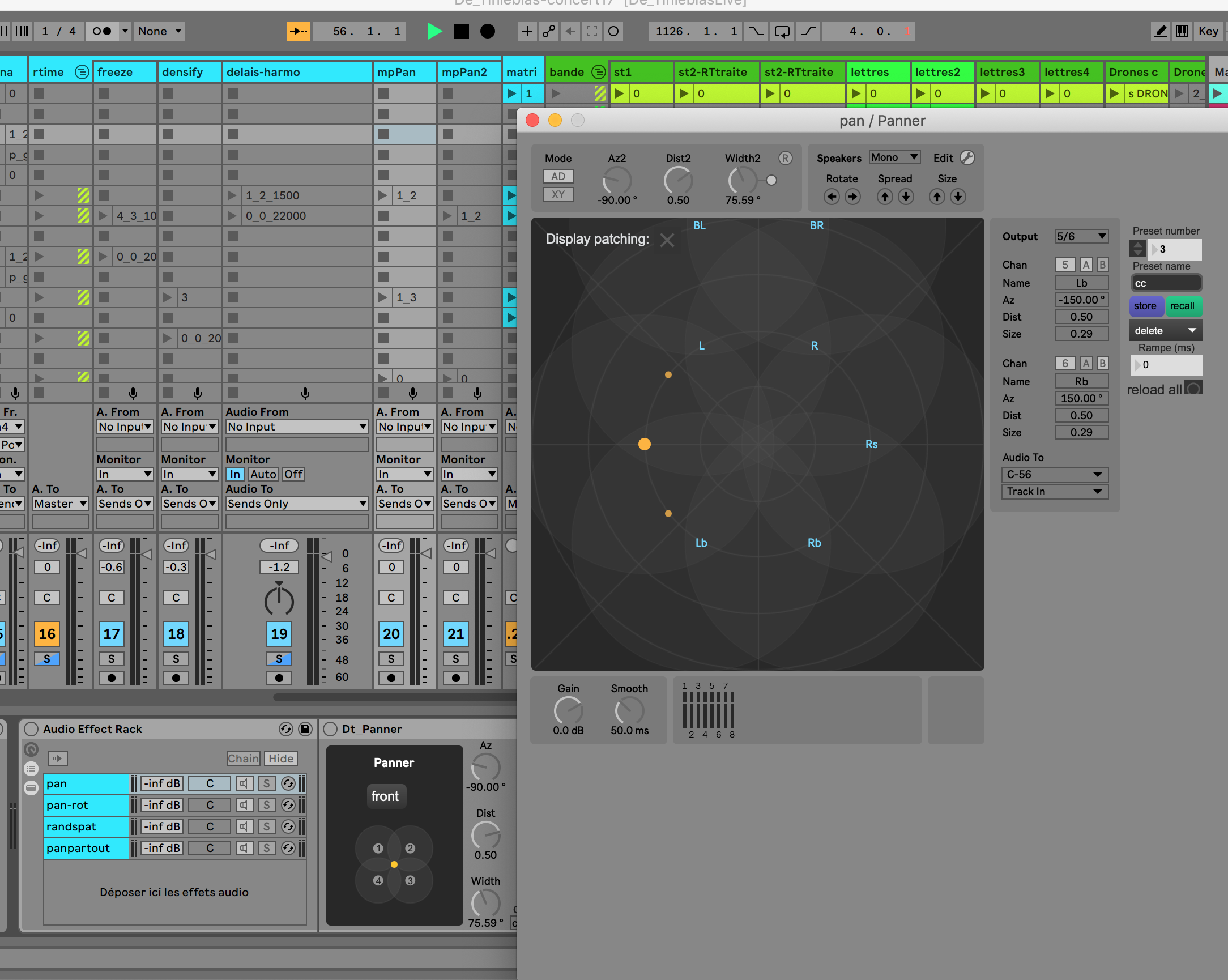
- ‘matrix’: The routing between realtime tratments is done by the matrix track. The routing is scripted by the name of the clips : a number provided as a name is interpreted as a preset number of the pattrstorage of the matrix.

- ‘bande’: this folder contains 11 tracks for soundfiles.

‘st1’ is for stereo soundfiles. The files are sent to some of the return tracks thanks to the enveloppe volume automation of the clips.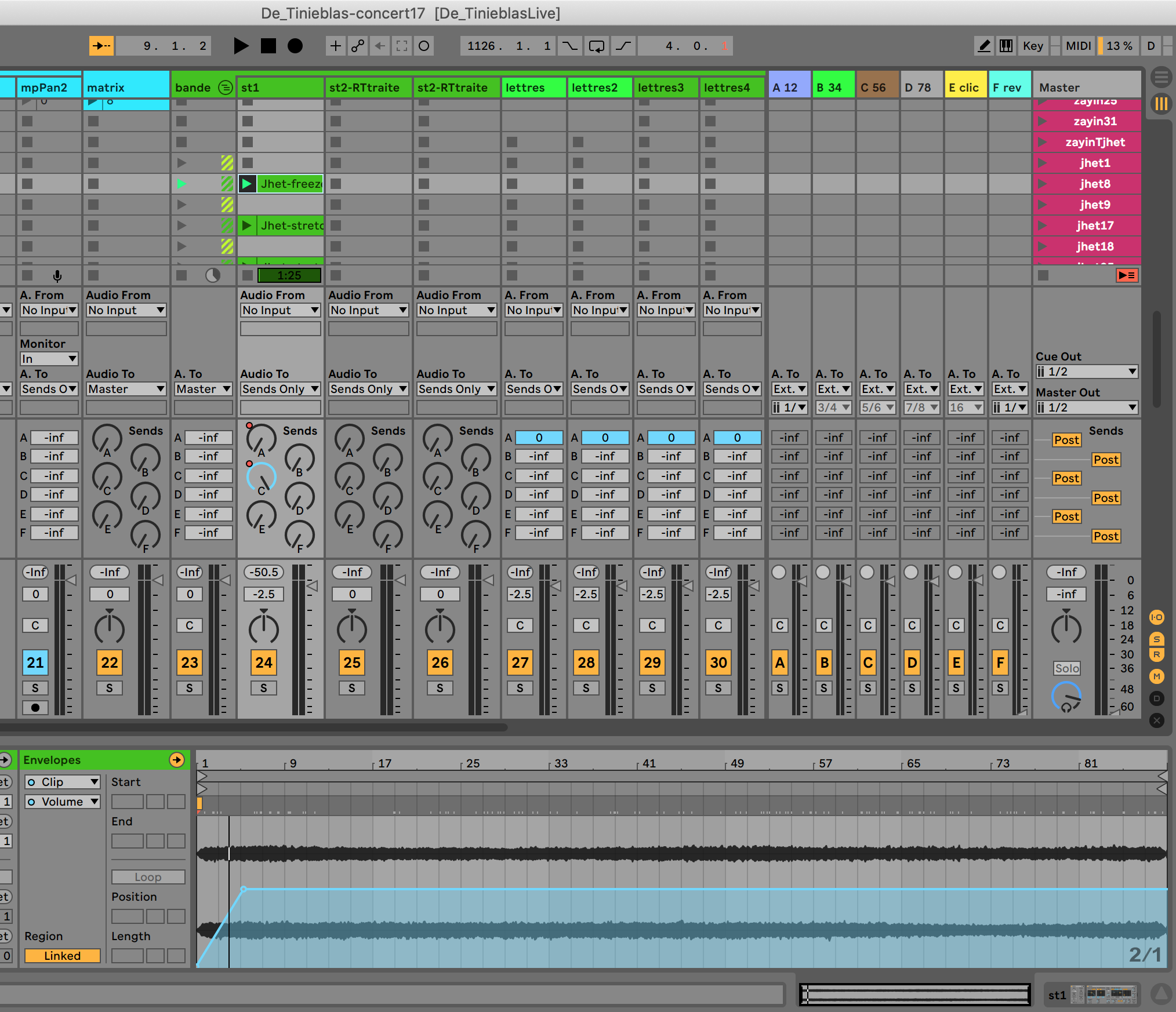
‘st2-RTtraitements’ is a track for soundfiles that can be processed by realtime treatments in their rack device.
Before playing the soundfile, the treatments are powered by playing a clip in the format ‘rack-i_preset-j’ (means power rack-i with preset-j).
‘st2-RTtraitements2’ is the a track similar to ‘st2-RTtraitements’.
‘lettres’ ‘lettres2’ ‘lettres3’ ‘lettres4’ are similar tracks to ‘st1’ with a different reverb.
‘Drones crossfade’, ‘Drone-trait’, ‘DRONE1’ and ‘DRONE2’ are used to play drones sequences. Drones are combinations of stereo files that we can listen to during the piece.
‘Drones crossfade’ is a track for cross-fading between folders DRONE1 and DRONE2.
‘Drone-trait’ is a realtime treatment applied on the active drone.
‘DRONE1’ is a folder of four stereo files constituting a drone.
‘DRONE2’ is a folder of four stereo files constituting a drone.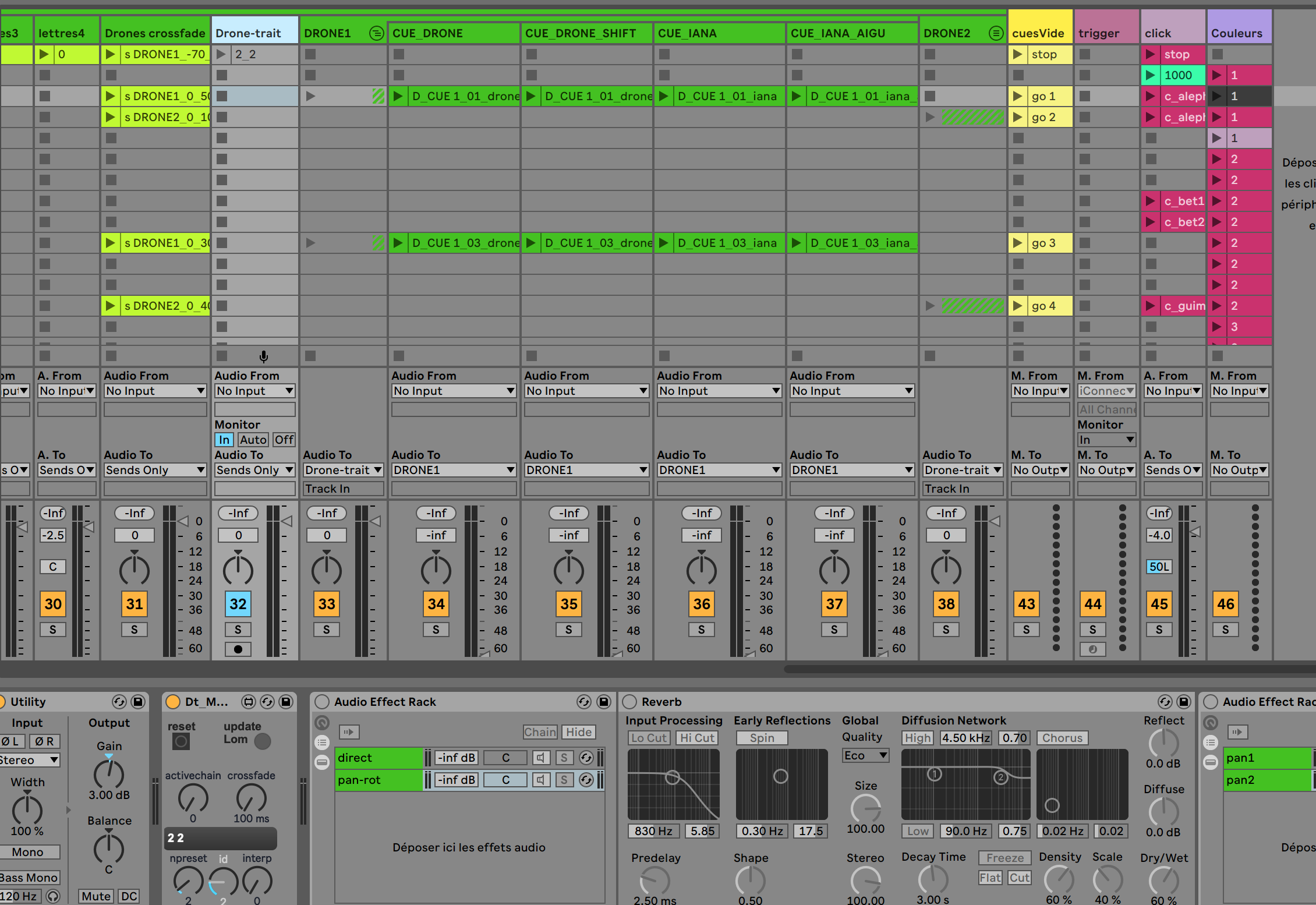
- ‘cuesVideo’: this track triggers the video sequences using osc. The name of the clips of the track is ‘go video-seq-i’ to trigger video sequence i. ‘stop’ stops and rewind mix16pro.

- ‘trigger’: is a track for trigerring the scenes from a midi external device. Choose the midi input device in the midi input menu of the track.

- ‘click’: this track can send an audio mono click track to return E. The name of the clips specify from which bar to start, ie ‘c_bet15’ means start click from bet15. A number i means trigger next scene after i ms. ‘stops’ stops the click.

- ‘couleurs’: does nothing (;-) but is useful for knowing the colours of the scene even if it is selected.
- Returns A B C D correspond to audio outputs 1-2, 3-4, 5-6, and 7-8. Return E is for click. Return F is for reverb.
- ‘Master’: this track contains the scenes to be triggered. The names of the scenes are the letters followed by the bar number. A color code is used: purple is for scenes triggered by the click-track. Maroon is for scenes to be triggered by hand. Black is for scenes automatically triggered after a certain amount of time.
6. Initialization routine
Video patch
Preload the video files one by one.
Main patch
Test click-track
Reset the patch: press twice key ‘$’
Init the patch: trigger scene ‘reset!!’.
You are ready to play.
7. System calibration and tests
Main patch
Test realtime effects one by one, test spatialisation, and listen to the soundfiles to adjust the levels.
Check the OSC communication with the video computer if video is played.
Check the mixing with the BCF2000.
8. Performance notes
Cues are written in the score ‘CUES-video-Stefano_Gervasoni_-De_tinieblas-_partitura_16.12.20—corr10.02.22’.
All brown scenes are to be triggerred by hand.
Purple scenes are triggerred by click.
Following parts are up to you to decide when triggerring the cues:
- zayinTjhet: wait black light and silence
- jhetTtet: wait black light and silence
- tetTyod: wait black light and silence
Main electronic treatments:
Aleph
bar18 Iana tutti
Bet
bar5 S5
bar13 +basseB8
bar26 tutti
bar27 tutti
Guimel
nothing
Dalet
1-4: groovechoir on tutti
He
1 long reverb tutti
Vav
Iana with tutti (mais serait mieux que les ténors I à IV puis C I à IV puis S I à IV puis B I à IV)
at the end Iana sur tutti
Zayin
tutti1 et tutti2
9 + Iana sur tutti
25 fshift sur tutti
Het
RAS (sfiles)
Tet
34 Iana tutti
Yod
tutti (reverb+Iana)
Caf
tutti
Lamed
soli left on groovechoir
soli right on groovechoir
Iana with tutti
Mem
Iana tutti
Nun
Iana tutti
24 groovechoir: tutti
27 tutti2
Updated at
Vous constatez une erreur ?
IRCAM
1, place Igor-Stravinsky
75004 Paris
+33 1 44 78 48 43
heures d'ouverture
Du lundi au vendredi de 9h30 à 19h
Fermé le samedi et le dimanche
accès en transports
Hôtel de Ville, Rambuteau, Châtelet, Les Halles
Institut de Recherche et de Coordination Acoustique/Musique
Copyright © 2022 Ircam. All rights reserved.